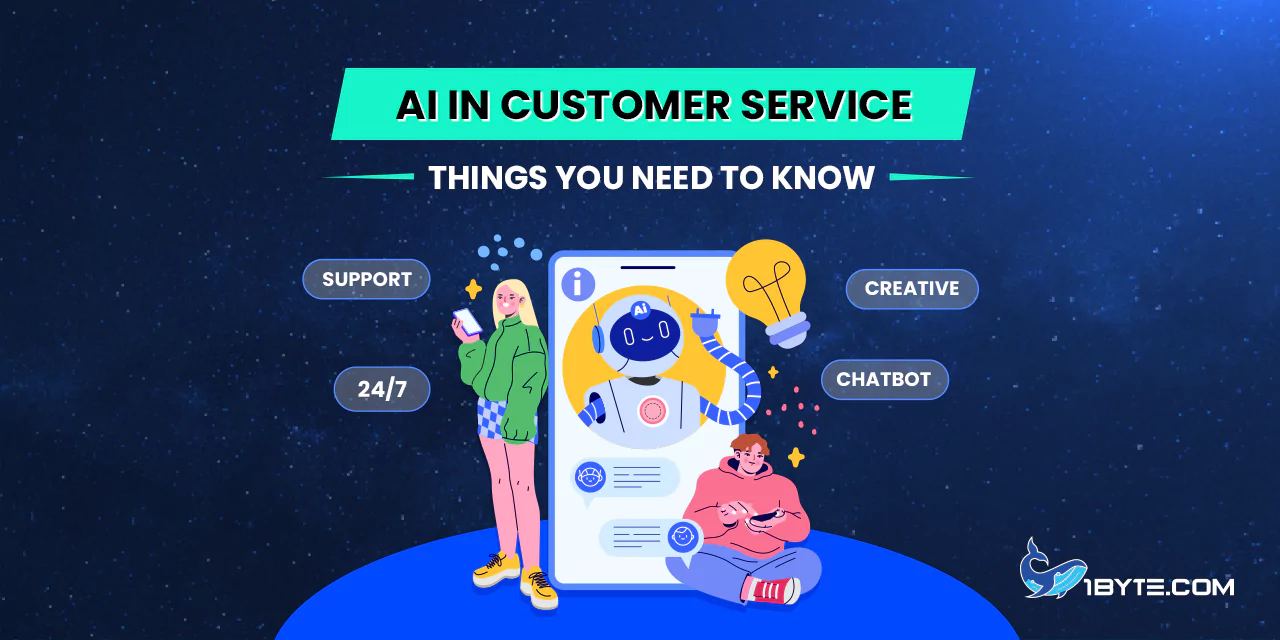Artificial intelligence (AI) is transforming the customer service landscape. Companies across industries are using AI-powered tools to handle inquiries, provide instant support, and personalize customer experiences. The global market for AI in customer service is booming, estimated at around $12 billion in 2024 and projected to reach nearly $48 billion by 2030. This rapid growth reflects a simple truth: AI in customer service is no longer a futuristic concept – it’s happening now. Businesses are leveraging AI to respond faster, work smarter, and meet rising customer expectations in a cost-effective way. Read this article from 1Byte to find out more.
How AI Is Transforming Customer Service
AI is changing how customer service teams operate by automating routine tasks and augmenting human agents. Unlike traditional customer support limited by human availability, AI-driven systems can provide 24/7 support and instant answers. For example, AI chatbots and virtual assistants can handle simple queries like order status or password resets, freeing up human agents for complex issues. This results in shorter wait times and higher efficiency. In fact, Gartner analysts predict that by 2026, AI “conversational agents” in contact centers will save businesses about $80 billion in labor costs by handling many interactions that would otherwise require a human representative.
Speed and efficiency are major benefits. AI systems can analyze customer questions in milliseconds and pull up relevant responses. This speed is crucial because consumers value quick service. According to a recent Statista survey, 82% of consumers would rather use a chatbot for immediate assistance than wait for a human agent. AI in customer service also enables scalability – one AI assistant can simultaneously chat with hundreds of customers, something impossible for human staff. This scalability was especially valuable during surges in contact volume (for instance, during the COVID-19 pandemic or holiday shopping seasons) when AI bots helped handle the extra load.

Personalization is another way AI is elevating customer service. Machine learning algorithms can analyze customer data and past interactions to tailor responses or offers. For example, an AI assistant might recognize a returning customer and proactively suggest solutions based on their history. This level of personalization can make customers feel understood without lengthy explanations. Furthermore, AI can ensure consistency in service quality by providing the same accurate information every time, reducing human errors.
Key Benefits of AI in Customer Service
Crucially, AI doesn’t just work instead of humans – it also works alongside them to enhance service quality. There are many benefits of AI in customer service.
Faster Response Times
AI can instantly answer common questions, leading to quicker resolutions. Companies like Lyft have deployed AI assistants that dramatically speed up support – Lyft’s AI chatbot cut average customer service resolution time by 87% after it was introduced. Customers appreciate getting solutions in seconds rather than minutes or hours.
Around-the-Clock Support
Unlike human agents who work limited shifts, AI support is available 24/7. This means customers can get help at midnight, on weekends, or during holidays. Businesses can assist global customers in different time zones without delay. Constant availability leads to higher customer satisfaction and captures potential sales that might have been lost after hours.
Cost Savings and Efficiency
Automating routine inquiries with AI reduces the workload on call centers and help desks, lowering operational costs. AI chatbots can handle a large volume of simple requests that would otherwise require paid staff time. Gartner estimates that widespread use of AI could cut costs so much that it yields the contact center industry tens of billions in savings within a few years. These savings can be reallocated to improving products or training staff for high-value interactions.
Handling High Volumes
AI in customer service scales effortlessly. Whether it’s 10 or 10,000 inquiries at once, an AI system doesn’t get overwhelmed. This is particularly useful for industries that experience seasonal spikes or sudden surges in inquiries. For example, e-commerce retailers see spikes on Black Friday, and airlines face surges during weather disruptions – AI systems can manage a flood of questions in real time, whereas scaling up human staffing for short periods is difficult.
Consistent Accuracy
Well-trained AI assistants provide consistent answers based on a company’s knowledge base and policies. This reduces the inconsistency that can occur with different human agents. When policies change, updating the AI’s responses ensures every customer gets the correct information immediately. Consistency builds trust – customers know they’ll get reliable answers regardless of when or where they ask.
Data Insights
AI tools can analyze customer inquiries to identify trends and common pain points. By tracking what customers ask and how they phrase problems, companies gain valuable feedback. These insights can inform improvements in products, services, or website FAQs. Essentially, every AI interaction can turn into actionable data. Some advanced AI systems even predict what customers might need next, allowing companies to be proactive.
Together, these benefits explain why AI in customer service has taken off so quickly. It’s not just about cutting costs – it’s about delivering better service at scale. Next, we’ll look at how different industries are applying AI to their customer support and the real-world results they’re seeing.
AI in Customer Service Across Industries
One of the most important things to know is that AI in customer service isn’t confined to any single sector – it’s being adopted across all industries, from finance to retail to travel. A recent survey showed that companies in sectors as diverse as energy, banking, and retail are implementing AI to assist customers. In fact, the energy/utilities sector had the highest share of companies using AI for customer service at 60%, closely followed by the financial services sector at 57%. This broad adoption underlines that every industry sees value in AI-driven support, whether it’s handling bank account inquiries or helping shoppers track orders.
Let’s explore a few major industries to see how they are leveraging AI in customer service, with specific examples:
Retail and E-Commerce
Retailers and e-commerce companies were early adopters of AI for customer service. They use AI chatbots on websites and messaging apps to answer product questions, assist with purchases, and even offer style recommendations. These virtual shopping assistants help customers find what they need faster. For instance, cosmetic retailer Sephora launched a chatbot that provides beauty tips and product suggestions to customers online. Similarly, clothing brands have experimented with AI-powered chat to help shoppers pick sizes or styles.
The impact is significant. Many online shoppers have grown comfortable interacting with bots during the buying process. A U.S. survey found that 44% of online consumers view chatbots as helpful for finding product information while shopping. This shows that nearly half of shoppers appreciate the instant help that AI assistants provide on retail sites. Retail chatbots can handle tasks like checking if an item is in stock, tracking a package, or processing a return – all without waiting for a human agent. This not only improves customer experience but also reduces the burden on support staff.
E-commerce giant Amazon is a well-known example of leveraging AI in customer service. Amazon uses AI behind the scenes for its customer support, including automated self-service returns and an AI-powered system that can predict and resolve common issues (like late deliveries) proactively. While Amazon doesn’t publicize all its stats, the scale of its operations suggests their AI handles millions of customer interactions. Another example is H&M’s virtual assistant, which can guide shoppers to outfit choices or check availability in the nearest store – showing how AI can act as a personal shopper at scale.
Banking and Financial Services
The banking and finance industry has embraced AI in customer service to provide quick, secure assistance to customers around the clock. Many banks now have AI-driven virtual assistants integrated into their mobile apps or websites. One high-profile example is Bank of America’s chatbot, Erica. Erica uses AI to help customers with tasks like checking balances, transferring money, or getting spending insights. It has been very successful – in 2023 alone, Bank of America clients interacted with Erica 673 million times, up 28% from the prior year. Since its launch, Erica has handled nearly 2 billion interactions, demonstrating how an AI assistant can scale to meet huge customer demand. Other banks like Capital One (“Eno”) and HSBC (“Amy”) have also launched virtual assistants to handle everyday customer requests.

AI in banking customer service isn’t limited to chatbots. Financial institutions use AI to detect fraudulent activity in customer accounts and to answer questions about transactions in real time. AI systems can authenticate customers’ identities using voice recognition when they call, adding security and saving time compared to manual verification. According to research by McKinsey, roughly half of customer contacts in banking (as well as telecom and utilities) are already handled by machines or automated systems – including AI. This means everything from balance inquiries to card activations are often processed without a human representative.
The result is faster service for customers and lower costs for banks. A simple example is password resets or card activation calls – these used to require speaking to an agent, but AI-driven self-service systems can now handle them instantly. Banks report that customers appreciate the convenience. Importantly, if the AI cannot solve an issue, it seamlessly hands off the customer to a human agent with full context of the conversation, ensuring no frustration or repetition. This hybrid model (AI + human) is becoming the standard in financial services.
Insurance and Healthcare
The insurance sector, including health insurance, is also reaping the benefits of AI in customer support. Insurers face heavy call volumes for claims, policy questions, and payments. AI assistants help handle these inquiries efficiently. A standout example is NIB, a private health insurer in Australia. NIB deployed an AI-powered digital assistant named “Nibby” to assist customers with health insurance inquiries and transactions. The results have been impressive – since 2021, NIB’s AI assistant has reduced the need for human support by 60%, cut incoming customer service phone calls by 15%, and saved the company $22 million in operating costs. This clearly shows AI delivering real ROI: Nibby handles routine questions and claims, allowing human staff to focus on complex, high-value cases. The AI was built using advanced language models (the same technology behind tools like ChatGPT), which means it can understand varied customer questions and provide relevant answers or actions.
Healthcare providers are also using AI chatbots to improve patient service. For example, some hospitals have symptom-checker chatbots on their websites. Patients can input their symptoms and get preliminary advice or directions (e.g., whether to seek urgent care or schedule a telehealth appointment). During the COVID-19 pandemic, these types of AI-driven tools helped triage patient inquiries when call centers were overwhelmed. Public health organizations, like the World Health Organization (WHO), even launched chatbot helplines on platforms like WhatsApp to answer millions of questions about COVID-19 automatically, providing information in multiple languages. This demonstrated AI’s ability to disseminate accurate information quickly on a global scale.
In life insurance and auto insurance, AI virtual agents guide customers through filing a claim step-by-step. They can answer FAQs about coverage or billing without making the customer wait on hold. Overall, insurance companies report faster processing and higher customer satisfaction for straightforward requests thanks to AI. Customers get immediate answers about their policy or claim status at any hour. Meanwhile, human representatives are still available for sensitive or complex cases, such as detailed claims or grievances, which require the human touch.
Telecommunications and Utilities
Telecommunications companies (internet, phone, cable providers) and utility companies (water, electricity) serve millions of customers who frequently need support – whether it’s troubleshooting an issue or starting a new service. These industries have turned to AI to help manage the massive volume of customer interactions. A prime example is Vodafone, one of the world’s largest telecom providers. Vodafone employs an AI chatbot named “TOBi” as a first line of support. TOBi interacts with customers through the company’s website and mobile app, handling common requests like billing questions, service outages, or plan upgrades. This significantly reduces wait times for customers and operational costs for Vodafone, while ensuring that customers with complex problems still get human assistance.
The telecom experience shows how AI in customer service can maintain quality at scale. Whether you have a simple question about your data plan or need to report a service problem at 2 AM, the AI assistant is ready to help immediately. Utilities are doing something similar. Power and water companies use AI chatbots to let customers report an outage, pay bills, or get information on usage. These bots handle repetitive queries (like “What’s my account balance?”) so that call center agents are free to address emergencies or complicated cases.
According to McKinsey, telecom and utility firms already automate roughly 50% of customer contacts using AI and other tech. The trend is continuing upward as natural language understanding improves. We’re also seeing AI voice assistants in these sectors – for example, when you call your cable company and the system understands your spoken request (“I have no internet connection”) and gives automated troubleshooting steps. These voice-driven AI systems are effectively replacing the old touch-tone phone menus with something far more user-friendly.
Travel and Hospitality
The travel and hospitality industry – including airlines, hotels, and ride-sharing services – relies heavily on customer service to support travelers around the world. AI is helping these companies serve customers faster and more personally. Many airlines now use AI chatbots on their websites or Facebook Messenger to answer frequently asked questions (FAQs) about flight status, baggage allowances, or COVID-19 travel restrictions. For instance, KLM Royal Dutch Airlines introduced a chatbot that can send booking confirmations, boarding passes, and flight updates to customers through social media messaging platforms. This proved convenient for passengers, as they could get travel info in one place without searching through emails or waiting on hold.
Ride-sharing and transportation companies are also leveraging AI in customer support. A recent headline-grabbing example is Lyft, the popular ride-hailing service. Lyft integrated a generative AI assistant (built with technology from Anthropic) into its customer service operations. The AI helps resolve rider and driver issues by guiding them through troubleshooting or refund processes. The impact has been dramatic – Lyft reported that its AI assistant reduced average customer support resolution times by 87%. What used to take a support agent several minutes to investigate and fix can now be done by the AI in a fraction of the time.
Hotels have also dabbled in AI-driven customer service. Some hotel chains use AI concierges – think of a chatbot or even a smart speaker in your hotel room that you can ask for extra towels, restaurant hours, or nearby dining recommendations. These AI concierges provide instant answers and free up hotel staff to focus on in-person guest needs. Additionally, travel companies often face multilingual customer bases, and AI translation capabilities enable a single chatbot to support multiple languages.
The Future of AI in Customer Service
Looking ahead, AI is poised to play an even more prominent role in customer service across all industries. One major driver is the advancement of generative AI, which can produce human-like text and handle complex conversations. Tools like ChatGPT have shown that AI can draft detailed answers, troubleshoot problems, and even detect tone or sentiment to some extent. Businesses are rapidly exploring how to integrate these next-generation AI models into their support centers. Gartner predicts that by 2025, eight out of ten customer service organizations will be using generative AI in some form – whether to assist human agents, generate response templates, or power customer-facing chatbots.
AI in Customer Service Getting Smarter
We can expect customer service AI to become more conversational and “smarter.” Instead of just answering pre-programmed FAQs, future AI assistants might handle end-to-end service processes. Imagine a travel chatbot that can not only answer questions about a flight, but also help you change your booking, issue you a new ticket, upsell you a hotel deal at your destination, and process your payment securely – all in one seamless chat. Companies like Expedia are already testing AI that can plan trips for customers via conversation. In e-commerce, AI might become a personal shopping concierge that understands your style and budget as well as a good human salesperson. The possibilities are expanding as the AI improves its ability to interpret context and intent.
Integration of AI with Voice and Omnichannel Support
Another trend is the deeper integration of AI with voice and omnichannel support. In the near future, the line between talking to a smart IVR (interactive voice response) system on the phone and chatting with an AI on a website will blur. The same AI engine could power both voice and text interactions, giving a unified experience. Already, voice assistants like Alexa and Google Assistant can handle some customer service tasks (for example, you can ask Alexa to check your bank balance or track a package). As companies connect their backend systems to these AI platforms, more customers will start using voice commands for service queries. It’s very likely that “voice AI in customer service” will grow alongside chatbots.
Human’s Role
Crucially, human agents will continue to be part of the loop, but their roles may evolve. With AI taking care of the simple cases, human agents will handle more specialized or escalated issues. They’ll also act as supervisors for the AI, intervening if the AI gets confused and training it over time with new knowledge. We’re already seeing job titles like “bot supervisor” or “conversation designer” emerge – people who design the flows for AI dialogs and make sure the AI aligns with the company’s brand tone and service quality. In this way, AI could elevate the role of customer service representatives, turning them into problem-solvers who use AI tools as part of their toolkit.

From a business perspective, the future points to competitive advantage for those who harness AI effectively. Faster and more personalized service tends to attract and retain customers. Companies that deploy AI strategically will likely see higher customer satisfaction and loyalty. They’ll also operate more efficiently, which can translate to better pricing or more investment in product improvements. On the flip side, companies that ignore the AI trend could find themselves struggling to meet customer demands for instant service or falling behind competitors that operate leaner support operations with AI. As one industry CEO put it, AI in customer service is shifting from a “nice-to-have” to a “must-have” in order to stay competitive in the digital age.
Leverage 1Byte’s strong cloud computing expertise to boost your business in a big way
1Byte provides complete domain registration services that include dedicated support staff, educated customer care, reasonable costs, as well as a domain price search tool.
Elevate your online security with 1Byte's SSL Service. Unparalleled protection, seamless integration, and peace of mind for your digital journey.
No matter the cloud server package you pick, you can rely on 1Byte for dependability, privacy, security, and a stress-free experience that is essential for successful businesses.
Choosing us as your shared hosting provider allows you to get excellent value for your money while enjoying the same level of quality and functionality as more expensive options.
Through highly flexible programs, 1Byte's cutting-edge cloud hosting gives great solutions to small and medium-sized businesses faster, more securely, and at reduced costs.
Stay ahead of the competition with 1Byte's innovative WordPress hosting services. Our feature-rich plans and unmatched reliability ensure your website stands out and delivers an unforgettable user experience.
As an official AWS Partner, one of our primary responsibilities is to assist businesses in modernizing their operations and make the most of their journeys to the cloud with AWS.
Conclusion
In conclusion, AI in customer service is a game-changer that every business should be watching. It’s already enhancing customer experiences across industries, from quick chats with retail bots to comprehensive banking assistance via virtual agents. The technology brings clear benefits – speed, availability, efficiency, and insights – but it also requires thoughtful implementation, keeping the human element in the loop. The statistics and examples we’ve explored show that AI is delivering real value today: huge interaction volumes handled, millions in savings, and faster help for customers. As AI continues to evolve, we can expect customer service to become even more proactive and tailored. Companies that understand the capabilities and limitations of AI, and use it to complement their human teams, will be best positioned to thrive in this new era of customer service. The bottom line is that AI in customer service is here to stay, and it’s something every organization – and customer – needs to know about and prepare for.

